Popular Mechanics, May 1960
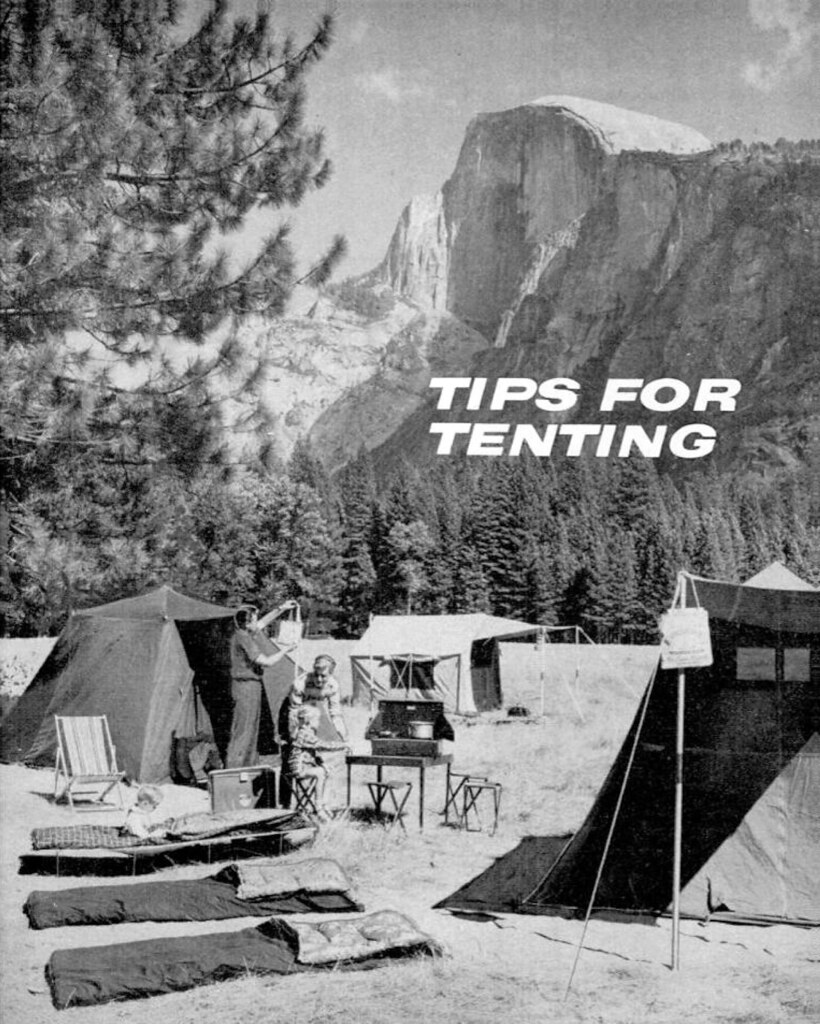
by Rafe Gibbs — DUSK WAS SETTLING DOWN several years ago on the banks of the St. Joe River in northern Idaho—but I wasn’t. I was struggling in the dim. tree-filtered light to read the directions on how to put up a spanking new umbrella tent.
My wife, who had started cooking operations, paused now and then to cast a hopeful glance at the man she married for worse. Fortunately, a neighboring camper strolled by. “My tent is just like yours.” he said.
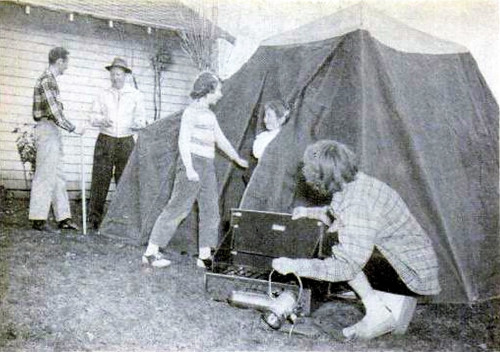
Erect tent in the back yard and check equipment before setting out on a
camping trip—especially if it is your first one.
“First, you nail down the bottom of the tent with those spikes in that sack over there; then you fix the umbrella ribs this way—be sure you don’t get them upside down—and next you step inside the tent and …”
That was lesson No. 1 in the art of tenting—an art that has become so popular in the U.S. that more tents are now sold annually in the country than were used by both Blue and Gray soldiers throughout the entire Civil War.
The modern umbrella tent, which has become a favorite with campers. is tricky to erect the first time. Simple, the second. So it’s a good idea to conduct a dry run with
a new tent in your own back yard before you start out on a camping expedition. It may be raining at your camp site.
Other equipment can do with some testing, too. Even if you have used a gas stove for years—and especially if you have—it’s a good idea to check it out.
While camped last summer with the family at Oregon’s huge Honeyman State Park, I was visited by a lady in distress. Her stove wouldn’t work. She had wandered through the camp looking for a stove just like hers. Ours matched. Would I help? Remembering the kindly gentleman of the St. Joe, I walked—for miles, it seemed —to the lady’s camp where her husband was busily munching cookies while awaiting her return. Disconcerted, I nevertheless went to work and, with a borrowed bobby pin, unclogged the gas line.
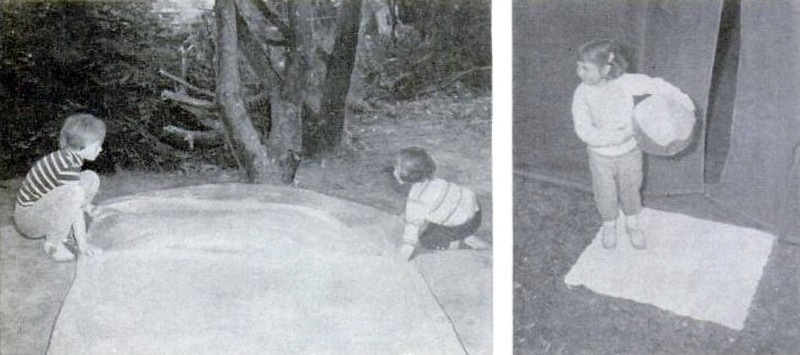
(Left) Sheet of heavy plastic (building-supply stores sell it) on the tent site prevents moisture from seeping through floor of tent. (Right) Tent floor stays clean if there’s a throw rug or towel at entrance for wiping feet.
Planning a camping trip with a family is a big part of the fun. Everybody takes an interest in lining up the gear. Besides, it’s fun just to take a look at it now and then and speculate on what is coming. It is recommended that you give assignments and establish responsibilities before starting. You will be pleasantly surprised to find how eagerly the children will carry them out.
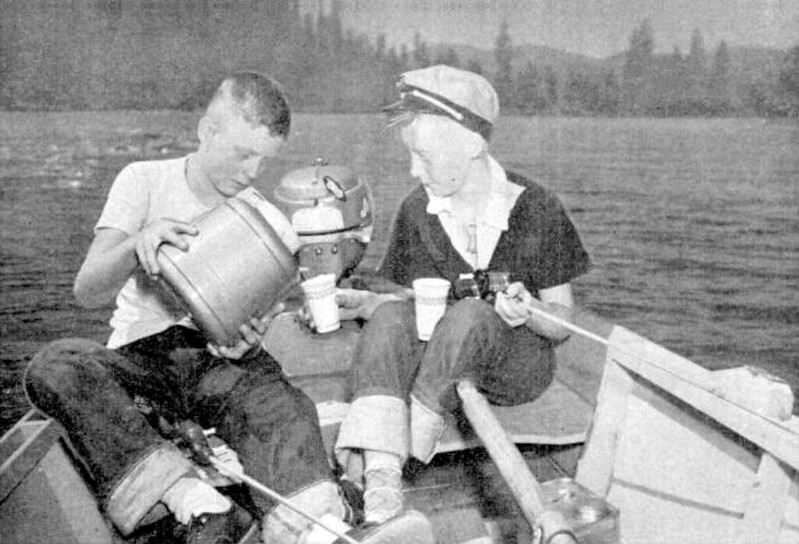
A water jug is almost indispensable in a car, boat and tent, particularly if children accompany you on a camping trip.
Air mattresses are standard equipment for camping now. If your lungs need exercise, you can blow and blow. But about $3 will get you a small and efficient hand pump. Beauty of this is that the youngsters will fight for the privilege of blowing up the mattresses. Even our five-year-old daughter insisted on taking her turn.
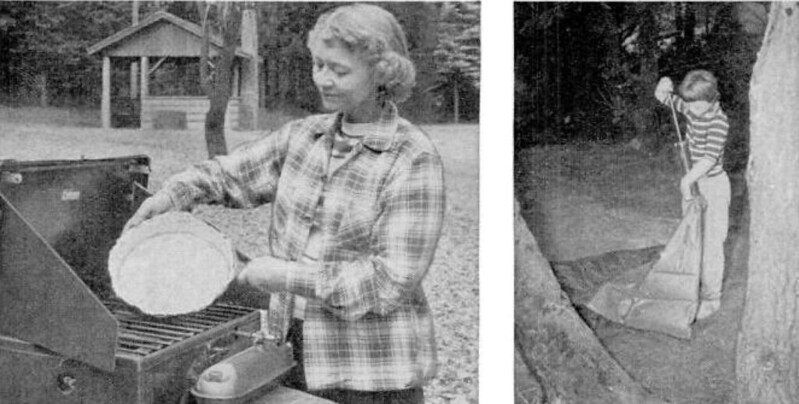
(Left) Having fish for supper? A piece of aluminum foil on the frying pan will make that job of dish washing afterwards a lot easier. (Right) Hand pump saves breath in inflating air mattress; children like to pump.
If the plastic valve stem on a mattress becomes worn and won’t hold in the pump, you can build the stem up again by applying plastic glue—the same material you use for patching the mattress. In a hurry, you can wrap some plastic tape around pump and valve sterns to hold them together.
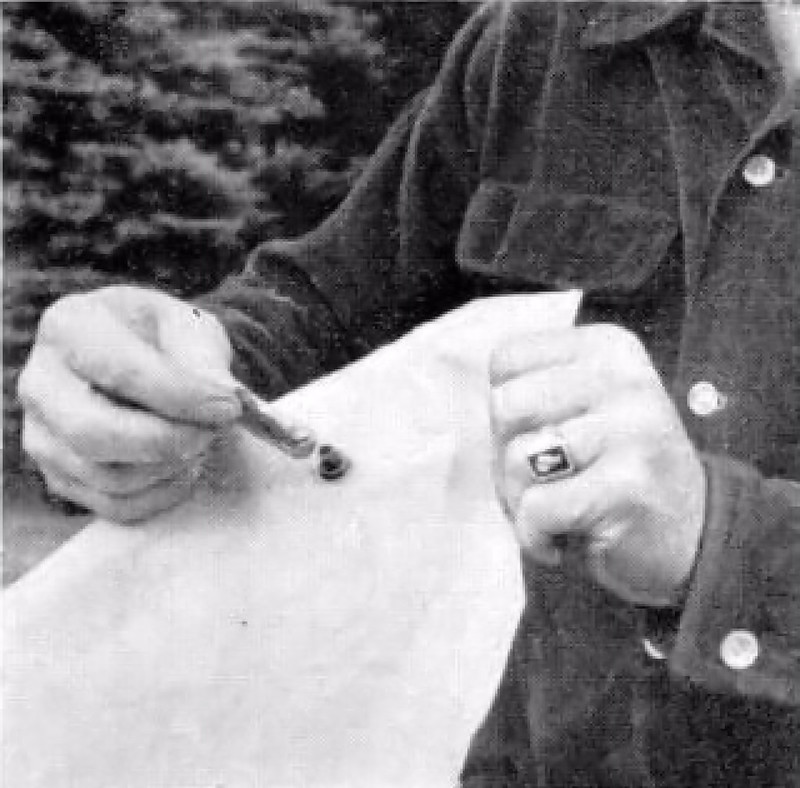
Worn plastic valves on air mattresses can be “built up” again by application of liquid plastic coating
Letting out the air from the mattresses should always be the first chore when you are breaking camp. The mattresses will be deflated when you are ready to take off. Incidentally, the mattresses make wonderful floats on a lake.
For additional recreation for the youngsters, carry along a spare inner tube and rope. Tie the rope to a tree limb, then attach it to the inflated tube. You have a swing which will attract playmates for your children from all over the camping area.
In national forests during fire seasons, you are required to have in your car a shovel, ax and pail. You might try picking up at an Army surplus store a folding shovel used by GIs for digging foxholes. Among other things, the shovel’s sharp point is excellent for scratching a small rain-runoff around your tent—and for digging clams on a beach.
A hatchet will serve, but a small handled ax is much better. Some of the wood you will have to chop is on the knotty side. The blade of the ax is also the best tool I have found for prying tent spikes out of the ground.
You can keep the chopping down to a minimum by looking for “squaw wood”—bits of dead trees found on the ground. Squaw wood serves as good kindling, and its bark makes the hottest fire with a low flame. If the woods are wet with rain, snap off dried twigs from tree trunks to get a fire going.
Cook on an open fire if you will. but a camp stove will keep everybody happier.
You need a stationary light of some kind. It can be either gas or battery powered, but you should have a light to place on the camp table in the evening, and in the tent upon retiring.
Another indispensable item is a water jug. It is handy to have in the tent at night, but even handier to have in the car while traveling. Many stops at service stations are saved. If you take a boat out fishing, the jug should go along.
Keep dishes—and dish washing—to a minimum. For $10, you can get a week’s supply of paper service for a family of four.
Probably the biggest saving in dish washing comes in the use of paper cups. We carry them in assorted sizes. Eight-ounce hot-drink cups for coffee and tea, nine-ounce cold-drink cups for milk and heat-of-the-afternoon beverages, and five-ounce cold-drink cups for water and breakfast fruit juices.
We bring along our regular silverware, but disposable forks and spoons can be used if vacation dish washing is to be kept to an absolute minimum. Many housewives today are using aluminum foil extensively in their cooking, but they too often forget it on vacation trips. Two or three rolls should be tucked in with the supplies.
My wife probably appreciates aluminum foil most when frying the day’s catch of fish. She molds a large piece of foil over the frying pan, and cooks the fish on this superimposed surface. The frying pan comes through the cooking process clean enough to require only rinsing.
Selecting the best possible camp site is highly important. In improved federal and state parks. the problem is relatively simple. Just try to get near a water faucet and avoid being too close to rest rooms which are used at night.
Midwesterners, I have noticed, when they first came to the timbered mountains of the West, are inclined to pitch tents in the deepest woods. If the woods are deep enough, they don’t warm up all day. And, if it has been raining, the tall timber can be downright uncomfortable. You want shade, but not too much.
Some camp sites in the mountains are of necessity in ravines, but avoid them if possible. The cool night air settles in the draws. And don’t pitch your tent where there is danger from rock slides or falling rocks. I have a friend who got quite a hole in his tent. He adds that he was lucky “not to get one in my head.”
Because you are camped in the mountains, you are not necessarily above the mosquito line. Last summer, one of my sons and I camped at high-altitude Lake Louise in Canada’s Banff National Park. As we ate our supper, the mosquitoes began dive bombing.
My son got an insect-killing bomb from the luggage compartment. Spraying this around the camp site and tent, he finished supper. By the time we were ready to hit the sleeping bags in the tent, there was not a mosquito in sight or sound. It was peaceful all night, although, once when I awoke, I heard a neighboring camper swatting desperately.
To help keep the floor of the tent free from ground moisture, place a piece of heavy plastic on the tent site before you erect the tent. If you carry gear on the top of your car, the plastic will do double duty as added protection against rain. The plastic is available at building-supply stores.
Then there is the matter of keeping the canvas floor of the tent clean. A big help is an old towel or throw rug placed at the entrance to the tent. Also handy is a “sawed-off” broom. Many campers use a child’s play broom or a whisk broom for sweeping the floor of the tent, but a regular broom with handle sawed off to size is most effective. The shortened broom will fit under the front seat of most cars.
If you have extra space—and careful packing will usually allow some—take along a rake with sawed-off handle. It will come in handy for clearing a mountain camp site.
Finally, as a highly important “be sure” item, be sure always to put gear—from ax to air mattress pump—in the car in exactly the same place each time. If you have to make camp in the dark, you will be happy you did. Even in the daylight, it is good to know just where everything is. Makes you feel at home on the trail.
As an assurance that you’re not forget-ting anything, run through this check-off list before you leave on a camping trip:
Shelter and Sleeping
- Tent (take a couple of extra tent spikes).
- Heavy plastic ground cloth.
- Throw-rug or towel for front of tent.
- Sleeping bags and pillows with cases.
- Air mattresses (include liquid plastic for repairs).
- Hand pump for mattresses.
- Broom with sawed-off handle.
Eating and Cooking
- Knives, forks, spoons, cups, plates. cereal or soup bowls. Paper cups and plates will add to the vacation: at least, use paper cups.
- Oilcloth table cover (wind may blow away a plastic tablecloth).
- Paring knife.
- Butcher knife.
- Large skillet. (Check to be sure it fits your camp stove.)
- Two saucepans and lids.
- Large kettle for heating water.
- Pancake turner.
- Mixing bowl.
- Measuring spoons and cup.
- Large unbreakable pitcher.
- Coffeepot.
- Toasting forks.
- Icebox (optional).
- Camp stove.
- Aluminum foil—regular and heavy.
Clean-Up Gear
- Vegetable brush.
- Dishcloths and towels.
- Paper towels.
- Soap powder, kitchen cleanser, scouring pads.
- Two dishpans (that will nest together).
Convenience Kit
- First-aid kit and medical supplies.
- Towels.
- Bath soap.
- Toilet tissue.
Tools
- Small ax.
- Short-handled shovel.
- Bucket.
- Pliers, hammer. nails. screwdriver.
Miscellaneous
- Clothespins.
- Rope.
- Flashlight.
- Lantern or stationary electric light.
- Insect repellent.
- Netting.
- Gasoline can.
- Gallon water jug.
- Canvas water bag if traveling in desert country.
- Folding chairs and table. (Optional, since tables and benches are provided in most improved state and national parks.)
* * *

